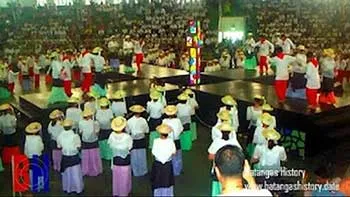The Folkloric Origin of the Subli Dance of Batangas from a 1916 Ethnographic Paper
Mention the word baraco and most people in the Philippines immediately think of Batangas, the province with which the liberica species of coffee is most often associated. In the performing arts, there is a dance that is just as instantly associated with Batangas: the “subli,” a hauntingly beautiful dance with contortive moves made by men and women to rhythmic beatings of the drum and clacking of castanets.
According to Michael H. Ramos, in an article published in the journal Asia Pacific Journal of Education, Arts and Sciences, the word “subli” was first thought of to have been a combination of the Tagalog words “subsob” and “bali.” In 1990, however, the academician Elena Mirano, Ramos went on, concluded that the word actually meant “salisi,” (alternately or in opposite directions1) a description of how dancers moved in opposite directions or conversely of one’s partner’s movements2.
Most references agree that “subli” has evolved into a ceremonial dance of worship of the Mahal na Poong Santa Cruz or the Holy Cross, patron of the Municipality of Alitagtag where the dance was supposed to have originated from.
READ: “The Legend of the Miraculous Holy Crosses of Alitagtag and Bauan”
A 1916 paper written by one Jose de Villa provides further insights about the origins of the “subli.” Citing folklore told during the era, he wrote:
“The subli is a form of religious ceremony which originated in the barrio of Alitagtag in Bauan where the Holy Cross, the patron saint of Bauan, was found. Formerly, it was danced only in that barrio, and at the front of the Holy Cross, but it is now danced everywhere. It was said that the first dance of its kind was performed by the women, that wife harshly treated by the husband, when after seeing her bucket being filled with water, sprang from her kneeling position and by his joy, did all the kinds of motions to express her thankfulness3.”
While by and large, de Villa’s paper was written in relatively good English, regrettably his narration of the folklore behind the “subli’s” origin was ambiguous. What did he mean by the phrase “by his joy?” Did the woman spring to her feet when the bucket filled with water at the sight of her husband? If so, why would she wish to express thankfulness when she was being treated harshly? Or should he have capitalized His if he was referring to a miracle from God?
An alternative folkloric story is given by Ted Hann at the web site Our Pastimes:
“The basic story is that a woman went to a well to get water, and there she found wood which was giving off water. Also on the wood was a traditional Filipino doll called a “naaginging.” People from many towns in the area came to see the wood and the doll, but no one was able to move it. After singing and dancing around the wood, they found they were able to move it. They then took the wood and carved it into a saint. The dance that allowed them to do this is the Subli4.”
De Villa did give further insights about the “subli,” calling it a somewhat “gymnastic” dance and that, while it originated in Alitagtag when it was just a barrio of Bauan, it eventually spread and was being danced “in every part of the province.” He wrote:
“The subli may be called a gymnastic dance for it consists of all movements which can only be performed by the trained dancers. The dancers are men and women castanets in their hands to keep time. They are kept separated together, and by means of some bodily movements, they understand which way to go and what position to make. The subli may consist of several partners each of whom play their parts. It is most interesting to see the subli, with the dancers hopping, sliding, inclining this way and that way or moving forwards and backwards, with their castanets beating the time, and with no music but the “tugtugan,” a kind of drum mounted on a small hollowed piece of wood, and the surface of alligator’s skin.
Although the subli originated in Bauan, it is now danced in every part of the province, generally on religious occasions and in front of images of saints. In exceptional festivities, expert dancers, of which many may form companies are invited from one town to another. Not all can dance the subli, for it requires hard and constant training before a person can dance5.”
2“Ang Dalawang Anyo ng Subli: Laro at Panata,” by Michael H. Ramos, published 2014 in the Asia Pacific Journal of Education, Arts and Sciences Volume 1 Number 4, online at Academia.
3“A Sociological Account of the Province of Batangas,” by Jose de Villa, p. 9 published 1916, online at the National Library of the Philippines Digital Collections.
4“The History of the Subli Dance,” by Ted Hann, online at Our Pastimes.
5De Villa, op cit., p 10.

